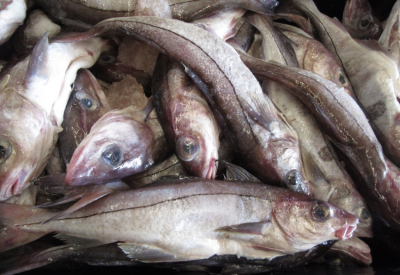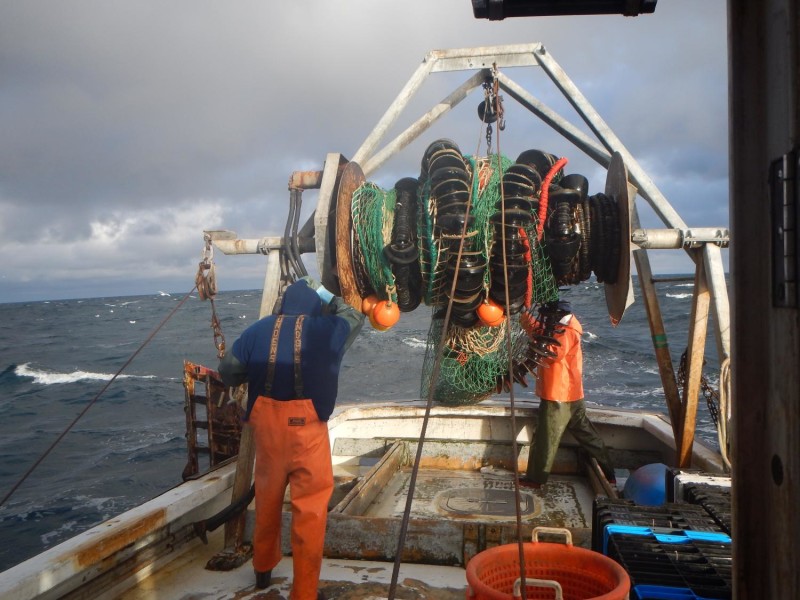When the new fishing year began May 1, Northeast ground fishermen faced new regulations and management.
In Massachusetts, some people are hopeful that a new cadre of aspiring fishermen in Cape Cod are paying close attention. That’s because a training program, offered by the non-profit Cape Cod Commercial Fishermen’s Alliance, is focused on bringing younger people into local fisheries — including learning about what it takes to enter into what has been described as “a graying fishery.” In New England, the average age of groundfish and lobster captains is 55 according to the New England Young Fishermen’s Alliance (NEYFA).
The Fishermen Training program offered by Cape Cod Fishermen’s Alliance links new or beginner fishermen to local fishing fleets, and offers potential opportunities in a very hands-on way. There was a time when everyone participating in the training might have been focused almost exclusively on learning about fishing on well-established species like cod and haddock. But, the dynamics of being a successful groundfisherman have shifted.
“I love hearing stories from the old timers about cod and haddock,” says Stephanie Sykes, the program and outreach coordinator of the Cape Cod Commercial Fishermen's Alliance, “whereas now, our gillnet fleets tend to target skates and dogfish.”
The training program has adapted to the realities of Cape Cod’s fisheries, including less of a focus on cod. “There are a few boats that still groundfish,” adds Sykes, “but their business is usually diversified.” In other words, groundfishing remains part of the training, but it is one small part of the larger equation for Cape Cod fishermen.
“One of the things I’ve seen over the past five years is a pivot to really strongly supporting and encouraging the diversification of a fishing business, to withstand a pandemic, market gluts, and other things,” says Sykes. “Diversification creates a more resilient fishing business.” Sykes knows firsthand about the importance of diversification now, as she is a commercial fisherman who used to gillnet for groundfish — but nowadays, focuses more on conch and black sea bass.
In places like Cape Cod, where the name reveals the one-time dominance of cod, shifting to and then educating consumers about other local (but less known) sustainable fish, such as hake, is one part of the solution. According to NOAA data, Atlantic cod was plentiful in the past, but by 2021, the catch dropped to about 1.3 million pounds harvested (valued at $2.9 million) — the lowest haul in recorded history. A 2019 stock assessment revealed that the Gulf of Maine cod was making “inadequate progress” toward rebuilding.
The regulatory New England Fishery Management Council (NEFMC), alongside various policy, management and commercial fishing partners, have been working for some time to rebuild Gulf of Maine cod. However, council spokeswoman Janice Plante says “the stock is classified ‘overfished,’ meaning the biomass is below where it should be, with ‘overfishing occurring,’ meaning fishing mortality is too high, since 2011, as well as in some of the years before that.”
A new plan from NEFMC (which is part of Framework 65) will implement a decade of low catch limits, with the goal of rebuilding the Gulf of Maine cod stock. It will also guide the 2023 fishing year.
The 10-year rebuilding period is strategic, adds Plante. “The Council could have selected a shorter rebuilding time, but that would have led to deeper cuts to commercial catches and recreational fisheries and would not have considered the uncertainties of natural mortality, climate change, and recruitment. The longer rebuilding period considers biology and the needs of fishing communities.”
With the stock and landings both struggling, and the amount of fishing pressure allowed being very low, the fishery industry has been staying within its allowable catch limits. “Yet still,” adds Plante, “overall biomass remains very low and we’ve had poor recruitment.” Unfavorable environmental conditions may likely prove to be a critical factor inhibiting the stock’s ability to rebuild.
Big increases for cod over the next decade remain unlikely, adds Plante. And in the short term will also remain low.
“Annual catch limits (ACLs) for Gulf of Maine cod were set last year (through Framework Adjustment 63) for fishing years 2022 through 2024 based on a constant acceptable biological catch (ABC). The Gulf of Maine cod rebuilding plan doesn’t change those ABCs or ACLs. The catch limit was set at a very low level for the 2022 fishing year and will remain at a similar level for 2023.”
In addition to Framework 65, there is also an expansion of at-sea monitoring and other new monitoring rules that Northeast groundfish fishermen will continue to adapt to.
Jerry Leeman is a commercial fisherman from Maine, who fishes mostly haddock these days, often for Blue Harvest Fisheries in New Bedford, Mass. As he sees it, overfishing of cod is not the main issue.
Leeman is also now founder and first executive director of the New England Fishermen Stewardship Association (NEFSA), a non-profit, nonpartisan advocacy group, a new advocacy group for New England fishermen seeks to “fight against needless regulation and offshore wind development threatening the viability of the American fishing fleet,” organizers say.
“Who’s overfishing? We’re down to about 17 active boats in the New England groundfishing fleet. Landings are low because no one is bothering. I’m seeing them up and down the seaboard! We run away from the damn things, because it costs us financially to catch them. You have to be on top of your game and stay away.”
Similar to cod, haddock stocks are facing pressures. In 2021, total commercial landings of haddock totaled around 16 million pounds and were valued at approximately $20 million, according to the NOAA Fisheries. But the Gulf of Maine haddock catch limit will also be significantly lower in fishing year 2023 than in 2022, because the most recent updated stock assessment indicated that biomass is much lower than expected. The catch limit for Gulf of Maine haddock is down 84 percent in the 2023 fishing year compared to 2022, while the Georges Bank stock is also down significantly.
Leeman says he is concerned about the haddock resource, and how it impacts his bottom line. “It’s going but it’s a matter of these restrictions that are about to come into play. They’re asking for a 83 percent reduction.”
As the May 1 start of the fishing year approached, the New England council asked the National Marine Fisheries Service to take emergency action “to address a critical Gulf of Maine haddock situation that is expected to result in significant fishery impacts during the 2023 groundfish fishing year,” according to a statement issued as the council wrapped up its April meeting at Mystic, Conn.
Council members learned that “fishermen have been encountering Gulf of Maine haddock at very high catch rates,” according to the council. “The proposed 2023 annual catch limit (ACL), however, is extremely low.”
One fishermen told of making one single trip when he caught so much haddock that it was equivalent to what his entire allocation will be for the 2023 season. Other fishermen have warned that an early shutdown of the fishery is very likely, with major impacts as a result.
Leeman, who was featured as part of a 2022 report by The New Bedford Light/ProPublica (“How Foreign Private Equity Hooked New England’s Fishing Industry” July 2022) that revealed the impacts of consolidation and private equity investment in the New Bedford groundfish fleet, feels the upcoming haddock cuts are not called for, in part, because they are based on assessments that do not reveal a full picture of stock abundance or health, and only cover a small area.
“I don’t think there should be a cut at all, there should be status quo, until we do an accurate biomass assessment,” says Leeman.
“If you go in the Gulf of Maine and catch haddock, it will cost you money. There are so few of us left in New England anymore. It’s hard to say about prices, to see what baselines are for allowable catch per year. When everyone who’s sitting on permits sees they need fish, it starts to be a price war.” He says he tries to stay optimistic, but that it can be a lot to manage.
“We’ll all be at the bread line if they keep it up. I don’t want to be a pessimist, but boats will just shut down.”

In an ideal world, Leeman says, things would be a bit different for ground fishermen. For one thing, he wishes he owned his own vessel, among other things.
“I’d prefer to be working back at home. Especially for guys like me doing long trips.” He says that the challenges of long times out at sea, then returning to shore is tough mentally, physically and financially–even for seasoned fishermen like him.
“I play dad, husband, play captain [and] attend meetings. Christmas was the closest to a day off I’ve had.” He says he worries about his crew, his responsibilities, and his way of life. Leeman said he had begun plans for his own association for like-minded New England fishermen, in early 2023 was working towards getting paperwork filed to start up the New England Fishermen Stewardship Association.
Time will tell how groundfishing fleets and markets respond once the fishing year kicks off in May 2023. In mid-January, cod was getting average prices of $4.35-$4.42 and haddock $2.03 at the Portland Fish Exchange fresh seafood auction in Maine. In early February, average prices in New Bedford Massachusetts were $2.68 for market cod and $2.26 for haddock.
Looking ahead, another factor that could potentially impact the management of cod in the future is a deeper understanding of stock structures. The Atlantic Cod Research Track Stock Assessment enabled NEFMC’s Atlantic Cod Stock Structure Working Group to look closely at cod stock structure. And the initial results, according to NEFMC’s Janice Plante “...concluded that we may have more than two cod stocks.”
The Gulf of Maine cod and Georges Bank cod stocks are already clearly recognized as distinct, but the working group concluded that there might be four or five stocks. Plante says the results of this analysis are expected to come out this summer.
“If the results reveal more than two stocks, a recommendation will be made to see how the stocks will be assessed separately on a management side and how the council will potentially transition to a possible new stock structure.” This study is still in the early phases and Plante adds, “nobody really understands the greater implications of this yet.”
With countries reducing fishing quotas, it remains to be seen whether farming operations will ever significantly impact markets. Norwegian based Norcod, which farms Atlantic cod, completed its first farmed harvest in 2020, and processed and sent samples to retailers and foodservice suppliers across 16 countries in Europe and the U.S.
But, for now, regulators, policy makers, fishermen and communities will continue to work to preserve the groundfish industry as best they can.







